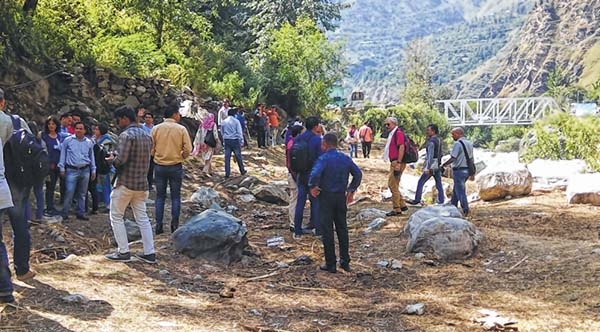Climate change, cloudburst haunt Kullu folks no end

Mungchan Zimik
Kullu, Sep 26 : People of Kullu district, living in Parvati valley region, still have grim memories of climate cruelty of cloudbursts that claimed the lives of many and the floods that devastated Parvati valley.
The villagers have drawn the attention of the Government to instal an advanced warning system in vulnerable areas ahead of natural/ man-made disasters and not to face the earlier fate.
A team of 40 members including journalists, experts, CMS staff visited Parvati valley under Kullu district of Himachal Pradesh to conduct a survey and to find out the risks and vulnerability of the local community.
It can be mentioned that Parvati valley has been identified as a major risk spot for monsoon floods, cloudbursts, landslides and potential Glacial Lake Outburst Flood (GLOFs).
The team held a brief interaction programme with the residents, former village Sarpanch, victims and officers of Climate Change Cell, Himachal Pradesh.
They all narrated the first cloudburst incident of Shat village in 1994 to the visiting team.
During the cloudburst, 27 persons lost their lives and resulted in heavy flood in the Parvati river.
In 2015 a landslide hit Manikaran Sahib Gurudwara, over the north bank of the Parvati river leaving 10 people dead and many injured.
The mountainous regions had been severely affected due to climatic events while the economically weaker section of the population are unaware of the severity of the region.
Instead of snowfall in high mountain, the locals have encountered yearly disasters including flash floods, rapid rise in temperature, windstorm, endemic diseases, heat waves particularly intermittent rainfall in the region.
Among several Indo Himalaya Region (IHR), Manipur is also equally facing the same climatic impact with scanty rainfall and shifting of rainfall pattern that has clearly indicated severity and vulnerability of climate change.
As compared to other North East States, Manipur and Himachal Pradesh (which comes under IHR) are witnessing changes in rainfall patterns.
There has been gradual shift of agricultural practices, loss of indigenous plantation thereby causing economic losses in both regions.
According to a report, the rise in mercury level in Parvati valley has forced apple plantation to be shifted to regions with higher altitudes.
The local farmers also said that apple cultivation is no longer sustainable in the region and as a result they have diversified to other cash crops such as Capsicum, Pomegranate and Mushroom for their livelihood.
This correspondent also witnessed the effect of climate change in Kullu district while interacting with the residents of Parvati valley.
The residents said that each year, extreme floods occur in mountain catchment causing economic losses as well as fatalities in the inhabited valleys downstream.
The causes of the flood include long duration of monsoon rainfall, local cloudbursts, intense downpours, glacier lake outburst floods, landslides etc.
According to them, at least 66 floods have taken place since 1965.
The flood assessment for Kullu district indicates variation in hazard levels for different catchment areas.
Data of the flood season normally lasts from June to September, with peaks in flood activity in July and August.
On the other hand, a four-day ‘National Media Consultation on Climate Change reporting in the Himalayas’ was organised by Centre for Media Studies while a trip to Himachal Pradesh was also organised to take stock of the ground situation.
Experts and intellectuals spoke on climate change on contemporary phenomenal climatic events in the Himalayan region at length.